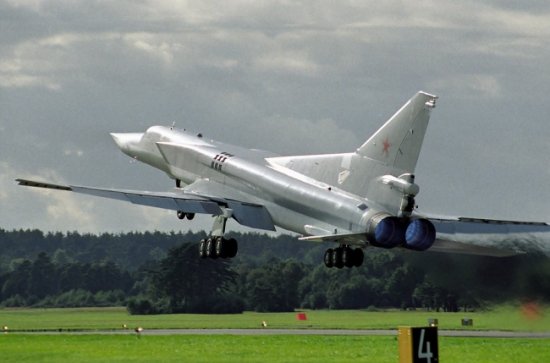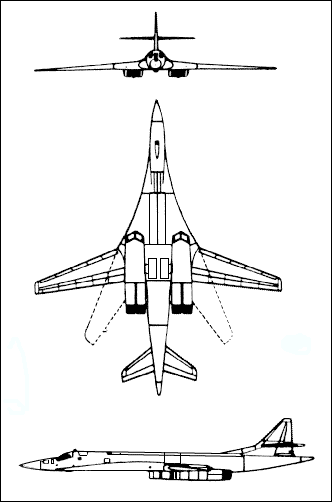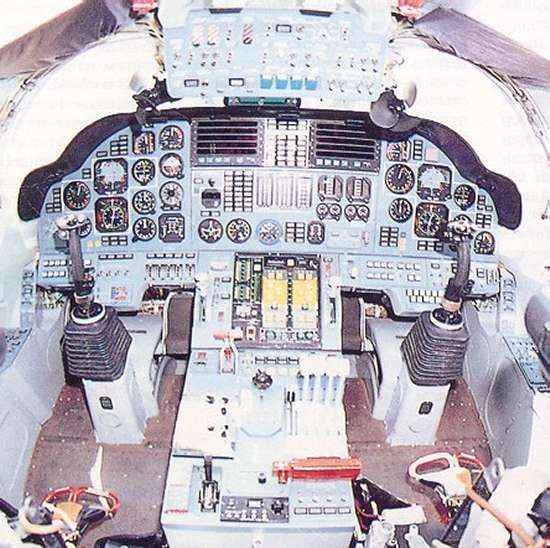Tupolev Tu-160 Blackjack
Long-range strategic bomber
سایر تصاویر
Tu-160 panel
Tupolev Tu-22M3

Tupolev Tu-22M3
The Tupolev Tu-22 had not proved particularly successful, in some respects being inferior to the earlier Tu-16. Its range and take-off performance, in particular, were definite weak points. Even as the Tu-22 was entering service, OKB Tupolev began work on an improved successor.
As with the contemporary MiG-23 and Su-17 projects, the advantages of variable-geometry wings seemed attractive, allowing a combination of short take-off performance, efficient cruising, and good high-speed, low-level ride. The result was a new swing-wing aircraft called Samolyot 145, derived from the Tu-22, with some features borrowed from the abortive Tu-98. The Tu-22M was based on the Tu-22's weapon system and used its Kh-22 missile. The Tu-22M designation was used to help get approval for the bomber within the Soviet system.[1]
The first prototype, Tu-22M0, first flew on 30 August 1969. The resultant aircraft was first seen by NATO around that time. For several years it was believed in the West that its service designation was Tu-26. During the SALT negotiations of the 1980s the Soviets insisted it was the Tu-22M. At the time, Western authorities suspected that the misleading designation was intended to suggest that it was simply a derivative of the Tu-22 rather than the more advanced and capable weapon it actually was.
General characteristics
- Crew: 4 (pilot, co-pilot, bombardier, defensive systems operator)
- Length: 42.4 m (139 ft)
- Wingspan:
- Spread (20° sweep): 34.28 m (112 ft 6 in)
- Swept (65° sweep): 23.30 m (76 ft 5 in))
- Height: 11.05 m (36 ft 3 in)
- Wing area:
- Spread: 183.6 m² (1,976 ft²)
- Swept: 175.8 m² (1,892 ft²)
- Empty weight: 58,000 kg (172,000 lb)
- Loaded weight: 112,000 kg (247,000 lb)
- Max takeoff weight: 126,000 kg (277,800 lb)
- Powerplant: 2× Kuznetsov NK-25 turbofans, 245 kN (50,000 lbf) each
Performance
- Maximum speed: Mach 2.05 (2,327 km/h,)
- Range: 7,000 km (4,971 mi)
- Combat radius: 2,410 km (1,500 mi)
- Service ceiling: 13,300 m (40,635 ft)
- Rate of climb: 15m/s (91ft/s)
- Wing loading: 688 kg/m² (147 lb/ft²)
- Thrust/weight: 0.40
Armament
- Guns: 1 × 23 mm GSh-23 cannon in remotely controlled tail turret
- Hardpoints: wing and fuselage pylons and internal weapons bay with a capacity of 21,000 kg (46,300 lb) of
- From up to 3 × Raduga Kh-22 missiles in weapons bay and on wing pylons or
- The Tu-22M3 can carry six missiles on a MKU-6-1 rotary launcher in its bomb bay, plus four missiles on two underwing pylons for a total of ten missiles per aircraft.or
- Various freefall bombs - 69 × FAB-250 or 8 × FAB-1500 might be typical.
The Kh-55 (AS-16 'Kent') long-range cruise missile was tested on the Tu-22M[9] but apparently not used in service.
گرداورنده انجمن نخبگان جوان
دوست عزیز، به سایت علمی نخبگان جوان خوش آمدید
مشاهده این پیام به این معنی است که شما در سایت عضو نیستید، لطفا در صورت تمایل جهت عضویت در سایت علمی نخبگان جوان اینجا کلیک کنید.
توجه داشته باشید، در صورتی که عضو سایت نباشید نمی توانید از تمامی امکانات و خدمات سایت استفاده کنید.











 پاسخ با نقل قول
پاسخ با نقل قول


علاقه مندی ها (Bookmarks)